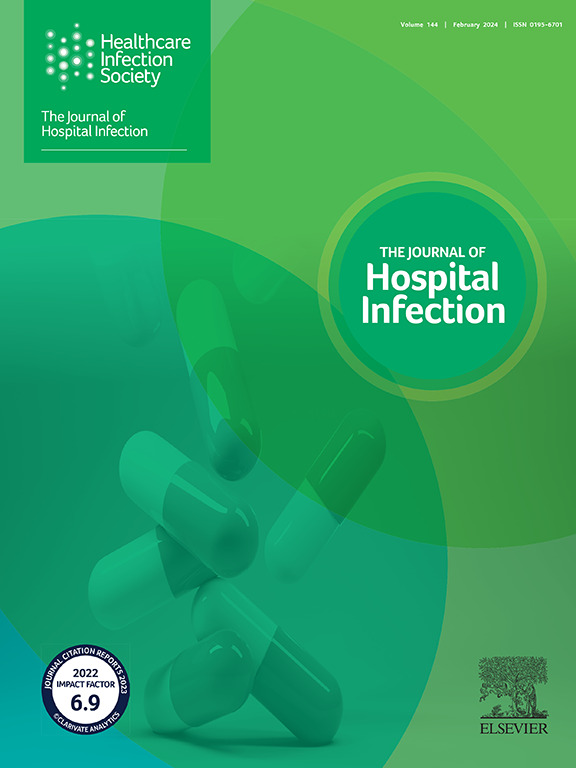Cumulative incidence of vancomycin-resistant Enterococcus faecium detection by patient characteristics or possible exposures: prioritization of patients for active screening culture
IF 3.9
3区 医学
Q1 INFECTIOUS DISEASES
引用次数: 0
Abstract
Background
The target population for active surveillance culture (ASC) of vancomycin-resistant Enterococcus species (VRE) by stool or rectal swabs has not been fully determined during VRE outbreaks in healthcare settings in non-VRE endemic situation.
Aim
To evaluate cumulative incidences of VRE detection during a vancomycin-resistant Enterococcus faecium outbreak to determine reasonable target populations for ASC.
Methods
Cases included inpatients whose first VRE-positive sample was obtained at Shizuoka General Hospital between February 2022 and January 2023, during which we conducted admission screening for possible high-risk patients, bi-weekly screening of all inpatients, admission and discharge screening in the high-care unit, and screening of contacts in each ward using stool or rectal samples. We calculated cumulative incidences of VRE detection for those screened by patient characteristics or possible exposure.
Findings
Among 60 cases identified, 55 (92%) were by ASC. Cumulative incidence was higher for contacts (6.4%, 15/234) than for those identified by other screening methods (0.5%, 40/8565). Among the patients identified through admission screening, those previously hospitalized in areas of reported VRE outbreaks had the highest cumulative incidence (6.6%, 5/78) followed by patients requiring toilet assistance (3.7%, 6/161). A bundle approach including ASC and prompt contact precautions by the hospital infection control team, local public health centre, and local and national infection control experts helped terminate the outbreak in seven months.
Conclusion
Patients with contacts, prior hospitalization in areas with known VRE outbreaks, and who need toilet assistance appear to be high-risk populations for VRE detection and are candidates for ASC.
根据患者特征或可能的接触情况,累计检测出耐万古霉素肠球菌的发生率:确定患者接受主动筛查培养的优先次序。
目标:在非 VRE 流行区的医疗机构爆发 VRE 疫情期间,粪便或直肠拭子进行耐万古霉素肠球菌 (VRE) 主动监测培养 (ASC) 的目标人群尚未完全确定。我们评估了耐万古霉素肠球菌爆发期间 VRE 检测的累积发生率,以确定 ASC 的合理目标人群:病例包括 2022 年 2 月至 2023 年 1 月期间在静冈综合医院首次获得 VRE 阳性样本的住院患者,在此期间,我们对可能的高危患者进行了入院筛查,每两周对所有住院患者进行一次筛查,在重症监护病房进行入院和出院筛查,并通过粪便或直肠样本对各病房的接触者进行筛查。我们根据患者特征或可能的接触情况计算了筛查对象的 VRE 累计检出率:在发现的 60 例病例中,55 例(92%)是由 ASC 感染的。接触者的累积发病率(6.4%,15/234)高于通过其他筛查方法发现的患者(0.5%,40/8565)。在通过入院筛查发现的患者中,曾在疱疹病毒爆发地区住院的患者累计发病率最高(6.6%,5/78),其次是需要如厕协助的患者(3.7%,6/161)。医院感染控制团队、当地公共卫生中心以及当地和国家感染控制专家采取了捆绑式方法,包括 ASC 和及时的接触预防措施,在 7 个月内终止了疫情:有接触者、曾在已知有 VRE 爆发的地区住院以及需要如厕协助的患者似乎是 VRE 检测的高危人群,也是 ASC 的候选者。
本文章由计算机程序翻译,如有差异,请以英文原文为准。
求助全文
约1分钟内获得全文
求助全文
来源期刊

Journal of Hospital Infection
医学-传染病学
CiteScore
12.70
自引率
5.80%
发文量
271
审稿时长
19 days
期刊介绍:
The Journal of Hospital Infection is the editorially independent scientific publication of the Healthcare Infection Society. The aim of the Journal is to publish high quality research and information relating to infection prevention and control that is relevant to an international audience.
The Journal welcomes submissions that relate to all aspects of infection prevention and control in healthcare settings. This includes submissions that:
provide new insight into the epidemiology, surveillance, or prevention and control of healthcare-associated infections and antimicrobial resistance in healthcare settings;
provide new insight into cleaning, disinfection and decontamination;
provide new insight into the design of healthcare premises;
describe novel aspects of outbreaks of infection;
throw light on techniques for effective antimicrobial stewardship;
describe novel techniques (laboratory-based or point of care) for the detection of infection or antimicrobial resistance in the healthcare setting, particularly if these can be used to facilitate infection prevention and control;
improve understanding of the motivations of safe healthcare behaviour, or describe techniques for achieving behavioural and cultural change;
improve understanding of the use of IT systems in infection surveillance and prevention and control.
 求助内容:
求助内容: 应助结果提醒方式:
应助结果提醒方式:


